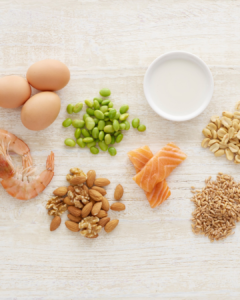
by gdadmin | May 3, 2025 | Uncategorized
If you’ve ever felt bloated, foggy, or fatigued after eating, you might have wondered whether you’re allergic to a food—or if it’s something else. Many people confuse food allergy and food intolerance, yet the two are very different in how they affect your body.
At Docere Wellness, we are happy to help you uncover the root cause of your symptoms, whether it’s an immune system reaction or a digestive issue. In this post, we’ll break down the key differences between food allergies and food intolerances, the signs to look out for, and how naturopathic care can help you find relief.

What Is a Food Allergy?
Food allergy is an immune system response. Generally, your body mistakenly identifies a specific food protein as harmful and produces IgE antibodies to fight it. Therefore, this reaction can trigger symptoms that range from mild to severe, and in some cases, life-threatening (anaphylaxis).
Common food allergens include:
-
Peanuts and tree nuts
-
Shellfish and fish
-
Eggs
-
Milk
-
Soy
-
Wheat (gluten)
Signs of a Food Allergy:
-
Itchy skin, hives, or rashes
-
Swelling of the lips, face, or throat
-
Difficulty breathing
-
Vomiting or diarrhea
-
Anaphylaxis (in severe cases)
Basically, food allergies usually appear quickly after eating the trigger food—often within minutes to a few hours.
What Is a Food Intolerance?
Accordingly, a food intolerance, on the other hand, is not an immune response. Evidently, it typically occurs when your digestive system has trouble breaking down a particular food. By all means, this could be due to an enzyme deficiency, sensitivity to food chemicals, or imbalanced gut flora.
One well-known example is lactose intolerance, where the body lacks the enzyme lactase needed to digest lactose in dairy.
Common intolerances include:
-
Lactose (dairy)
-
Gluten or wheat (non-celiac)
-
Fructose (fruit sugar)
-
Caffeine
-
Food additives (e.g., MSG, sulfites, artificial colors)
Signs of Food Intolerance:
-
Bloating and gas
-
Fatigue
-
Headaches or migraines
-
Brain fog
-
Irritability or mood swings
-
Skin issues (eczema, acne)
-
Joint pain
-
Cramping or irregular bowel movements
Unlike allergies, symptoms may appear hours to days after consuming the food, making them harder to pinpoint.

Allergy vs. Intolerance: The Key Differences
| Aspect |
Food Allergy |
Food Intolerance |
| Involves Immune System? |
Yes (IgE-mediated) |
No |
| Reaction Time |
Immediate (minutes–hours) |
Delayed (hours–days) |
| Severity |
Can be life-threatening |
Usually chronic or uncomfortable |
| Common Symptoms |
Swelling, hives, breathing issues |
Bloating, fatigue, brain fog |
| Diagnosis |
Skin prick test, blood test (IgE) |
Food sensitivity testing, elimination diet |
How Do We Test for Food Reactions?
With all these, we offer personalized food reaction testing to help you uncover whether you’re dealing with an allergy or intolerance. Here’s what we may recommend:
1. IgE Food Allergy Testing
This test measures immediate immune responses to common food allergens. Hence, it helps diagnose true allergies and can guide you toward proper avoidance and emergency planning if needed.
2. IgG Food Sensitivity Testing
IgG reactions are delayed immune responses, often associated with food intolerances or sensitivities. This test covers 100+ foods and helps identify the triggers behind chronic symptoms like bloating, fatigue, and migraines.
3. Elimination Diet + Symptom Tracking
In some cases, we guide you through a structured elimination diet, followed by a reintroduction phase. This is a gold-standard approach to finding subtle intolerances and improving gut health.
4. Digestive Function Testing
If we suspect enzyme deficiencies, candida overgrowth, or gut flora imbalances, we may assess your digestion and recommend enzymes, probiotics, or targeted nutrition protocols.

Naturopathic Support for Food Allergies & Intolerances
As a matter of fact, you don’t have to manage food reactions on your own. Correspondingly, we look beyond avoidance strategies to support your body’s healing and resilience. Here’s how:
✅ Gut Healing Protocols
A healthy gut lining is key to reducing food sensitivities. For this reason, we use nutrients like L-glutamine, zinc, quercetin, and herbs to strengthen your intestinal barrier and reduce inflammation.
✅ Anti-inflammatory Diet Support
Given that, we guide you in crafting a nutrient-dense, satisfying, allergen-free diet that supports energy, mental clarity, and digestive health.
✅ Immune Regulation
For those with allergies, we work on calming the immune response through adaptogens, antioxidants, and immune-modulating nutrients.
✅ Stress & Lifestyle Coaching
In addition, chronic stress worsens both allergies and intolerances. For instance, our team helps you implement natural stress-reducing techniques and lifestyle changes that promote long-term healing.
I caught up with my family in California over the prior week for a holiday. Because of this, I wanted to write and let you know changes I’d seen in my mother since you treated her with NAET. On our prior visit, before Mom’s NAET sessions with you, she spent time every day in her room away from the group, resting.
As far as I know, the GP and specialists were testing her for everything they could think of with no success. Concurrently, I also noticed she tended towards negative gossip which was unlike her. However, on this visit, she had no stomach ailments, dizzy spells, nausea or excessive fatigue. She was bright and bubbly, and happy to socialise. For instance, if she saw foods that she recognized to have dairy, she would say she had to avoid it as it gave her stomach troubles. For the most part, she did eat many foods with dairy during our visit. She and I shared a tasting platter of gelato. Surprisingly, she didn’t realise it had cream in it. She enjoyed it very much. No stomach ache or vomiting followed.
My sister noted to me that she hasn’t seen Mom get sick after eating dairy since the NAET treatments.
Thank you for all that you did for my mother. I just wanted to let you know about the successes with her NAET therapy.
Now, she’s back to enjoying meals without discomfort—and knows exactly what her body needs.
Do You Suspect a Food Allergy?
Given these points, unexplained symptoms like low energy, skin issues, or digestive discomfort could be linked to what you’re eating. To emphasize, we offer food reaction testing and personalized healing plans to help you feel your best again.
✅ Book your consult today!
Final Thoughts: You Deserve Clear Answers
Accordingly, food allergies and food intolerances are often misunderstood, misdiagnosed, and overlooked—especially when symptoms are vague or delayed. For that reason, we believe that every person deserves to understand how their body responds to food and feel confident in their daily meals.
Most importantly, let’s work together to uncover your triggers, repair your gut, and restore your energy—naturally.
Ready to Get Started?
🔹 Book Online: https://docerewellness.janeapp.com/ or call us at 403.452.6262
🔹 Visit us in-person at 15-7750 Ranchview Drive NW, Calgary, Alberta T3G 1Y9

by gdadmin | Apr 9, 2025 | Uncategorized
As the snow begins to melt and the days grow longer, many of us welcome spring with open arms. However, for allergy sufferers, this seasonal shift often brings a wave of symptoms—from sneezing and nasal congestion to itchy eyes and fatigue. What most people don’t realize is that two major allergy triggers overlap during this transitional time: snow mold and tree pollen.
Understanding how these allergens affect your body—and how to manage them naturally—can help you embrace the season with energy, clarity, and a healthy immune system.

What Is Snow Mold, and Why Should You Care?
When snow melts away, it creates a damp environment—perfect for fungal growth. Snow mold is a type of fungus (most commonly gray snow mold and pink snow mold) that grows underneath the snow during winter and becomes airborne in early spring as the ground begins to dry. You don’t have to be a gardener or spend hours outside to be affected; microscopic spores become airborne and can irritate the respiratory system, especially in those with mold sensitivities or asthma.
Common symptoms of snow mold allergies:
Enter: Tree Pollen Season
Right after snow mold kicks in, tree pollen season begins. Trees such as birch, oak, maple, and elm release fine pollen grains into the air as part of their reproduction cycle. Moreover, these allergens can travel for miles on a windy spring day, and they’re small enough to get deep into the respiratory tract—causing both upper and lower respiratory symptoms.
People often blame colds or viruses for their symptoms, but if your sniffles linger more than 10 days or seem to come back every spring, seasonal allergies could be the culprit.
The Perfect Storm: Snow Mold + Tree Pollen
In places like Calgary, Alberta—or anywhere with a long winter and sudden spring thaw—the combo of snow mold and early tree pollen creates a double-whammy effect on your immune system. Additionally, this transition puts your body on high alert, potentially overloading your histamine response and leaving you feeling depleted and foggy just as you’re ready to enjoy the outdoors.
Whether you’re sensitive to one or both triggers, there are powerful naturopathic and wellness-based strategies to help you reduce symptoms, support your immune system, and thrive during spring. Here’s what we recommend:

1. Clear Out Allergens Naturally
-
Spring Cleaning: Dust, mold spores, and pollen can collect inside your home. Accordingly, vacuum with a HEPA filter, wipe down surfaces, and wash bedding regularly.
-
Nasal Rinsing: Use a saline rinse or neti pot to clear allergens from your nasal passages and reduce inflammation.
-
Air Purifiers: HEPA air purifiers in your bedroom can significantly reduce your exposure to airborne allergens.
2. Support Your Immune System With Food
Your body’s ability to process and eliminate allergens efficiently depends heavily on gut and liver health. Thus, try incorporating these immune-friendly foods:
-
Turmeric & Ginger: Natural anti-inflammatories that can calm allergy symptoms.
-
Leafy Greens (like kale and spinach): Rich in antioxidants and chlorophyll for detox support.
-
Omega-3s (from flaxseeds, chia seeds, or salmon): Reduce inflammation and strengthen the immune system.
-
Fermented foods: Kefir, coconut yogurt, sauerkraut—these help keep your gut microbiome balanced and resilient.
-
Local honey (if tolerated): Some people report reduced pollen sensitivity over time by consuming raw, local honey.
3. Herbal and Nutritional Support
Several herbs and supplements can naturally reduce histamine levels and support detox pathways:
-
Quercetin: A natural antihistamine found in apples, onions, and supplements.
-
Nettle Leaf: Traditionally used to treat seasonal allergies—try it as a tea or in capsules.
-
Vitamin C: Helps break down histamine and supports the immune system.
-
Probiotics: A balanced gut means a balanced immune response.
-
Butterbur: Some research shows it can relieve allergy symptoms similarly to over-the-counter antihistamines.
Always consult your naturopath or healthcare provider before starting new supplements. Furthermore, if you’re on medication or managing a chronic condition.
4. NAET and Allergy Desensitization
If you’re looking for long-term relief, treatments like NAET (Nambudripad’s Allergy Elimination Techniques) offer an alternative approach to managing environmental allergies. Significantly, NAET uses a blend of kinesiology, acupuncture, and nutrition to identify and reprogram the body’s response to allergens.
Whereas, addressing allergies at the energetic level, many clients find lasting relief without relying on antihistamines or decongestants. Evidently, it’s helpful for individuals who experience overlapping symptoms or multiple environmental triggers.

5. Massage & Detox Therapies for Immune Support
Spring is also a wonderful time for detox massage or lymphatic drainage, which helps the body eliminate waste and allergens more efficiently. Specifically, these therapies:
At our clinic, we offer seasonal wellness packages that include detox massage, NAET treatments, and immune support consults tailored to this unique time of year.
6. Stay Hydrated and Rested
Water helps flush allergens from your system and keeps mucous membranes healthy. Your goal should be 2-3 liters per day, especially if you’re experiencing congestion or dry throat.
Don’t underestimate the power of rest—your immune system does most of its repair work while you sleep. Aim for 7–9 hours per night, and reduce screen time before bed to support melatonin production and deep sleep.
7. Mind-Body Support for Seasonal Allergies
Stress can worsen allergy symptoms by triggering the release of cortisol and histamine. Surprisingly, try to incorporate gentle mind-body practices such as:
By reducing stress and increasing oxygen flow, these habits help calm the nervous system and promote a healthier histamine response.
Final Thoughts: Spring Can Be Joyful Again
You don’t have to suffer through another spring with a tissue box in hand. Undoubtedly, understanding your body’s seasonal sensitivities—and supporting your immune system holistically—can make all the difference.
Have you been struggling with persistent sinus congestion, fatigue, or brain fog every spring? Then this may be the year to take a more proactive, natural approach. Our clinic is here to support you with:
✅ Personalized Naturopathic Consultations
✅ NAET Allergy Desensitization
✅ Seasonal Detox Massage
✅ Targeted Immune Support Programs
Ready to Breathe Easier This Spring?
We highly recommend to try our Immune Enhancer IV or Allergy Support Shot
Click here to book now or call us at 403.452.6262 to learn more.

by gdadmin | Mar 6, 2025 | Uncategorized
Gua Sha is more than a trend—it’s a powerful healing technique rooted in Traditional Chinese Medicine (TCM). Not only does it help relieve pain, but it also aids in reducing inflammation and improving overall well-being. Moreover, this gentle practice is gaining popularity worldwide due to its effectiveness in promoting natural healing

What is Gua Sha?
A TCM technique where the practitioner gently scrapes the skin with a smooth-edged jade or rose quartz tool. As a result, this method boosts circulation, promotes lymphatic drainage, and enhances the body’s natural healing process. Furthermore, applying light to medium pressure creates temporary redness—called “sha”—which signals improved blood flow and toxin release. In addition, studies show that Gua Sha provides strong anti-inflammatory effects, making it especially beneficial for those with asthma, chronic pain, migraines, and muscle tension.
The Benefits of Gua Sha
By incorporating Gua Sha into your wellness routine, you can experience relief from various health concerns, including:
✅ Relieving muscle tension and stiffness
✅ Enhancing circulation for better skin and overall health
✅ Reducing inflammation and supporting the immune system
✅ Easing headaches, migraines, and chronic pain
✅ Promoting relaxation and reducing stress
✅ Supporting respiratory health, including relief from coughs and congestion
What to Expect During a Treatment
Expect your session with Dr. Marcia Gray at Docere Wellness will be a calming and therapeutic experience. Here’s what you can expect:
Application of Oil: natural, nourishing oil is applied to the treatment area for smooth gliding.
Gentle Scraping Motion: jade stone or specialized Gua Sha tool is used in long, consistent strokes across your skin.
Treatment Duration: Sessions last 15–30 minutes and can be combined with acupuncture or cupping for enhanced results.
Temporary Redness: Light bruising or redness may appear but typically fades within a few days as circulation improves.

Who Can Benefit from It?
Are you struggling with any of the following concerns? Gua Sha is the perfect solution for you:
- Neck and shoulder tension
- Back pain and muscle stiffness
- Headaches and migraines
- Stress relief and relaxation
- Immune system support
Post-Treatment Care for Maximum Benefits
To make the most of your Gua Sha session, be sure to follow these simple self-care tips:
- Drink plenty of water to stay hydrated and aid detoxification.
- Avoid strenuous exercise for 24 hours to allow your body to heal.
- Keep the treated area warm and covered to maintain energy flow.
- Skip cold foods and drinks, as they can counteract the therapy’s warming effects.

Is It Safe?
When performed by a trained professional, Gua Sha is a safe and effective therapy. Open communication with your practitioner is key—let them know if you need adjustments in pressure to ensure a comfortable experience.
Ready to experience the healing power of Gua Sha?
Book your session today with Dr. Marcia Gray at Docere Wellness and take the next step toward natural healing and rejuvenation!
#GuaSha #TraditionalChineseMedicine #NaturalHealing #PainRelief #InflammationRelief #HolisticHealth #TCM #WellnessJourney

by gdadmin | Feb 5, 2025 | Uncategorized
A Milestone in Holistic Wellness
This year marks the 15th anniversary of Docere Wellness Centre, a significant milestone in our commitment to providing comprehensive, patient-centered care in Calgary, Alberta. Over the past decade and a half, we’ve dedicated ourselves to educating the community on disease prevention and the maintenance of optimal health through holistic approaches. As we reflect on our journey, we are filled with gratitude for the trust and support of our clients, staff, and the broader Calgary community.

The Inception: A Vision for Integrative Health
Fifteen years ago, Docere Wellness Centre was founded with a clear mission: to facilitate the body’s innate healing capabilities by offering the best healthcare for the entire family. Our vision was to inspire individuals to take an active role in caring for their mind, body, and spirit.
Why We Started
We recognized the need for a healthcare model that not only addresses symptoms but also delves into the root causes of health issues, promoting long-term wellness. Over the years, we have remained committed to this philosophy.
Evolving with the Holistic Wellness Landscape
Over the years, the field of holistic health has seen significant advancements. At Docere Wellness Centre, we’ve continually adapted to incorporate these developments into our practice.
Our Expanding Services
Our services have expanded to include a diverse range of therapies aimed at supporting our clients’ health and well-being at every life stage:
- Naturopathic Medicine: Combining effective traditional therapies with current advances in modern medicine, our naturopathic approach focuses on personalized treatment plans.
- Holistic Nutrition: Our holistic nutritionists educate and assist clients in maintaining a healthy quality of life.
- Life Coaching: We empower clients to maximize their personal and professional potential.
- Reiki: A holistic therapy that stimulates natural healing abilities.
- Massage Therapy: Enhancing circulation and promoting healing through targeted techniques.
- Psychological Services: Providing a safe space for mental wellness and emotional support.
- NAET (Nambudripad’s Allergy Elimination Techniques): A non-invasive method to eliminate allergies.

Transforming Lives: Success Stories of Holistic Wellness
The true measure of our success lies in the countless individuals whose lives have been transformed through our care.
What Our Clients Say
We’ve had the privilege of guiding clients on their journeys to overcome chronic health challenges, achieve optimal wellness, and embrace healthier lifestyles. Their testimonials highlight the effectiveness of our holistic, patient-centered approach and the dedication of our practitioners.
Lessons Learned: The Importance of Personalized Care
Throughout our 15-year journey, we’ve learned that personalized care is paramount. Each individual is unique, and a one-size-fits-all approach does not suffice in healthcare.
A Holistic Wellness Approach to Healing
By listening attentively and creating collaborative partnerships with our clients, we’ve been able to treat the whole person, not just the illness. We prioritize addressing root causes rather than merely alleviating symptoms.
Looking Ahead: The Future of Docere Wellness Centre
As we celebrate this milestone, we remain committed to evolving and expanding our services to meet the changing needs of our community.
Our Plans for Growth
We plan to introduce new therapies and wellness programs, continue our focus on education through workshops and our updated blog, and strengthen our collaborative partnerships within the healthcare community.
Join Us in Celebration: Special Anniversary Offers
To commemorate our 15th anniversary, we’re excited to offer exclusive promotions to our valued clients:
We appreciate you, and what better way to show our gratitude than with an exciting GIVEAWAY!
One lucky winner will receive a 15-item wellness gift basket packed with Gift Cards to your favorite wellness spots, Premium Supplements for optimal health, and Healthy Food Items to nourish your body.
How to Enter:
Giveaway Duration: February 1st – February 28th
Don’t miss out – the more you engage, the better chances to win!

15% OFF Special
In celebration of our anniversary, enjoy 15% off these rejuvenating services throughout the month of February:
-
Facial Acupuncture – Restore balance and glow with this ancient therapy.
-
Lymphatic & Detox Massages – Cleanse, rejuvenate, and boost your body’s natural detox systems.
-
Immune IVs – Keep your immune system strong and healthy, especially during seasonal changes.
Book now and save! https://docerewellness.janeapp.com/
Special Offer for Consults (For one month only!)
From February 15 to March 14, we will be offering 1-hour consults for $50 with 4th year intern Nour Nafisa. These visits will be supervised by Dr. Meghji.
Book Your Consultation here: https://docerewellness.com/
Conclusion: A Heartfelt Thank You
As we reflect on 15 years of holistic healing, we extend our deepest gratitude to our clients, staff, and the Calgary community. Your trust and support have been instrumental in our journey, and we are honored to be a part of your path to wellness. Here’s to many more years of health, healing, and holistic care!
📅 Book your consultation today and experience the Docere Wellness difference!
👉 Visit Our Website to explore services and special offers.

by gdadmin | Jan 2, 2025 | Uncategorized
The holiday season is a time of celebration, indulgence, and togetherness. While these moments of joy bring immense happiness, they can also introduce hidden risks to our health, particularly to our hearts. One such risk is Holiday Heart Syndrome, a condition that often goes unnoticed until it manifests in alarming symptoms. At Docere Wellness Center, we believe in empowering you with knowledge to make informed decisions about your health. Let’s dive deep into what Holiday Heart Syndrome is, why it happens, and how you can protect your heart during the festive season.
What is Holiday Heart Syndrome?

Holiday Heart Syndrome refers to irregular heart rhythms (arrhythmias) that are often triggered by holiday-related stressors such as excessive alcohol consumption, overeating, stress, and lack of sleep. First coined in 1978, this term highlights the correlation between festive indulgence and heart health issues, particularly in people without pre-existing heart conditions.
The most common arrhythmia associated with Holiday Heart Syndrome is atrial fibrillation (AFib), a condition where the heart’s upper chambers beat irregularly. This can lead to palpitations, dizziness, shortness of breath, and even chest discomfort.
Why Does Holiday Heart Syndrome Happen?
The holiday season often involves a combination of factors that can stress the heart. Here are the key contributors:
1. Alcohol Consumption
Alcohol is a major trigger for irregular heart rhythms. It’s not uncommon for festive gatherings to include cocktails, wine, or champagne, but excessive consumption can irritate the heart’s electrical system, leading to arrhythmias.
2. Overeating
Rich, salty, and fatty foods are staples of holiday feasts, but they can place extra strain on the heart. High sodium intake, in particular, can lead to increased blood pressure and fluid retention, both of which stress the cardiovascular system.
3. Stress and Emotional Strain
Holiday preparations, family dynamics, and financial pressures can elevate stress levels. Chronic stress increases cortisol production, which can disrupt the heart’s rhythm and overall function.
4. Lack of Sleep
Late-night parties and disrupted routines often lead to insufficient sleep. Sleep deprivation weakens the body’s ability to recover and can exacerbate the effects of other risk factors, like alcohol and stress.
5. Dehydration
With alcohol consumption and inadequate water intake, dehydration becomes a common issue. Proper hydration is crucial for maintaining optimal heart function, and its absence can lead to arrhythmias.
Who is at Risk?
Holiday Heart Syndrome can affect anyone, but some individuals are more susceptible than others. Key risk groups include:
- Middle-aged and older adults: Age increases susceptibility to arrhythmias.
- Those with underlying conditions: People with high blood pressure, diabetes, or a history of heart disease are at greater risk.
- Frequent drinkers: Regular alcohol consumption amplifies the risk.
Even if you are generally healthy, the combination of holiday indulgences can increase your chances of experiencing this condition.
Symptoms to Watch For

It’s essential to recognize the symptoms of Holiday Heart Syndrome early. These include:
- Palpitations: Feeling like your heart is racing, fluttering, or pounding.
- Dizziness or lightheadedness: A sense of imbalance or faintness.
- Shortness of breath: Difficulty catching your breath, even during light activity.
- Chest discomfort: Pain, tightness, or pressure in the chest.
- Fatigue: An unusual sense of tiredness or weakness.
If you experience any of these symptoms, especially if they persist, it’s crucial to seek medical attention promptly.
How to Prevent Holiday Heart Syndrome
The good news is that you can enjoy the holiday season while taking steps to protect your heart. Here are some practical tips:
1. Moderate Alcohol Intake
- Limit yourself to one or two standard drinks per occasion.
- Alternate alcoholic beverages with water or non-alcoholic options.
- Avoid binge drinking, as it’s a primary trigger for arrhythmias.
2. Make Heart-Healthy Food Choices
- Prioritize whole, nutrient-rich foods like vegetables, fruits, lean proteins, and whole grains.
- Limit salty, fatty, and sugary dishes, which can strain the heart.
- Practice portion control and savor your meals mindfully.
3. Manage Stress Effectively
- Incorporate relaxation techniques like deep breathing, meditation, or yoga into your daily routine.
- Delegate holiday tasks to reduce your workload.
- Set realistic expectations for yourself and your family to minimize holiday stress.
4. Stay Hydrated
- Drink plenty of water throughout the day, especially if you’re consuming alcohol.
- Herbal teas and electrolyte-rich drinks can also help maintain hydration.
5. Prioritize Sleep
- Aim for 7-8 hours of quality sleep each night.
- Maintain a consistent sleep schedule, even during holiday festivities.
- Create a relaxing bedtime routine to wind down after a busy day.
6. Stay Active
- Incorporate light physical activity like walking, dancing, or yoga to counterbalance holiday indulgences.
- Exercise helps reduce stress, improve circulation, and maintain heart health.
How We Can Help
At [Your Wellness Center Name], we’re here to support your heart health and overall well-being during the holiday season and beyond. Our services include:
- Nutritional Consultations: Personalized guidance to help you make heart-healthy choices during the holidays.
- Stress Management Programs: Relaxation techniques and lifestyle strategies to reduce holiday stress.
- IV Therapy: Hydration and nutrient support to replenish your body and support cardiovascular health.
- Holistic Health Assessments: Comprehensive evaluations to identify and address your unique risk factors.
Our team of experts is dedicated to helping you maintain a balance between celebration and health.
When to Seek Help

If you experience symptoms of Holiday Heart Syndrome, don’t wait for them to resolve on their own. Seek immediate medical attention if:
- Symptoms are severe or persistent.
- You have a history of heart disease or other risk factors.
- You’re experiencing chest pain, which could indicate a more serious condition.
Early intervention can make all the difference in preventing complications.
Final Thoughts
The holiday season should be a time of joy, not a source of stress for your heart. By understanding the risks of Holiday Heart Syndrome and taking proactive steps to mitigate them, you can celebrate safely and healthily. At [Your Wellness Center Name], we’re committed to helping you navigate the festive season with confidence and care. Together, let’s make this holiday season your healthiest yet.
Ready to take charge of your heart health? Contact us today to book your consultation and learn more about our holiday wellness programs!
Disclaimer: This blog post is for informational purposes only and should not replace professional medical advice. Always consult with a healthcare professional for any health concerns.




















